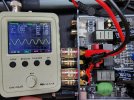Warning, complete noob here but I do have a few questions.
Found a pair of Dali Oberon 1 locally but still quite lost as to which amplifier to use. It's for desktop usage so the smaller/lighter the better, if i can plug it into the TV via optical/BT it'd be nice though it's not mandatory, room is 10m², speakers are 90cm~ away or roughly 3m when watching TV though as said earlier, if not possible to use it on the TV as well it's not mandatory. Planning on adding a subwoofer later and keep it 2.1 forever.
I've searched for amplifiers locally but I've only found those huge integrated amps like the Marantz PM6007 ($675), Yamaha A-S301 ($550) and A-S501 ($845), Cambridge AXA35 ($510 or $380 used) , Onkyo A9110 ($575) etc which seem quite overkill for my case (as well as bulky) so I'm thinking of going with a more budget option and these chinese amps caught my eye.
Would this amp be an adequate choice considering I don't need a ton of connectivity for multiple devices or more power to fill a giant room? I've read and from the little I understood it seems I can just plug any active subwoofer on the aux out and be done with a great-sounding 2.1 setup. Did I get anything wrong? And are there any better or more interesting options with a budget of up to $200? What if I up that to $300 or $400? Also have a Topping DX1 if it helps in any way.
Found a pair of Dali Oberon 1 locally but still quite lost as to which amplifier to use. It's for desktop usage so the smaller/lighter the better, if i can plug it into the TV via optical/BT it'd be nice though it's not mandatory, room is 10m², speakers are 90cm~ away or roughly 3m when watching TV though as said earlier, if not possible to use it on the TV as well it's not mandatory. Planning on adding a subwoofer later and keep it 2.1 forever.
I've searched for amplifiers locally but I've only found those huge integrated amps like the Marantz PM6007 ($675), Yamaha A-S301 ($550) and A-S501 ($845), Cambridge AXA35 ($510 or $380 used) , Onkyo A9110 ($575) etc which seem quite overkill for my case (as well as bulky) so I'm thinking of going with a more budget option and these chinese amps caught my eye.
Would this amp be an adequate choice considering I don't need a ton of connectivity for multiple devices or more power to fill a giant room? I've read and from the little I understood it seems I can just plug any active subwoofer on the aux out and be done with a great-sounding 2.1 setup. Did I get anything wrong? And are there any better or more interesting options with a budget of up to $200? What if I up that to $300 or $400? Also have a Topping DX1 if it helps in any way.


